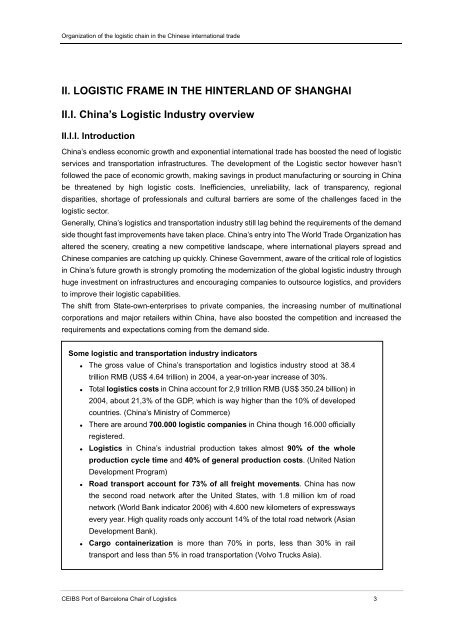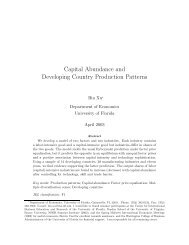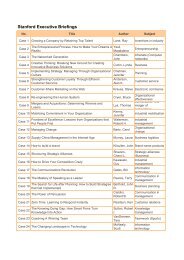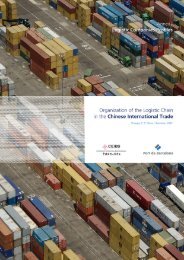Untitled - China Europe International Business School
Untitled - China Europe International Business School
Untitled - China Europe International Business School
You also want an ePaper? Increase the reach of your titles
YUMPU automatically turns print PDFs into web optimized ePapers that Google loves.
Organization of the logistic chain in the Chinese international trade<br />
II. LOGISTIC FRAME IN THE HINTERLAND OF SHANGHAI<br />
II.I. <strong>China</strong>’s Logistic Industry overview<br />
II.I.I. Introduction<br />
<strong>China</strong>’s endless economic growth and exponential international trade has boosted the need of logistic<br />
services and transportation infrastructures. The development of the Logistic sector however hasn’t<br />
followed the pace of economic growth, making savings in product manufacturing or sourcing in <strong>China</strong><br />
be threatened by high logistic costs. Inefficiencies, unreliability, lack of transparency, regional<br />
disparities, shortage of professionals and cultural barriers are some of the challenges faced in the<br />
logistic sector.<br />
Generally, <strong>China</strong>’s logistics and transportation industry still lag behind the requirements of the demand<br />
side thought fast improvements have taken place. <strong>China</strong>’s entry into The World Trade Organization has<br />
altered the scenery, creating a new competitive landscape, where international players spread and<br />
Chinese companies are catching up quickly. Chinese Government, aware of the critical role of logistics<br />
in <strong>China</strong>’s future growth is strongly promoting the modernization of the global logistic industry through<br />
huge investment on infrastructures and encouraging companies to outsource logistics, and providers<br />
to improve their logistic capabilities.<br />
The shift from State-own-enterprises to private companies, the increasing number of multinational<br />
corporations and major retailers within <strong>China</strong>, have also boosted the competition and increased the<br />
requirements and expectations coming from the demand side.<br />
Some logistic and transportation industry indicators<br />
� The gross value of <strong>China</strong>’s transportation and logistics industry stood at 38.4<br />
trillion RMB (US$ 4.64 trillion) in 2004, a year-on-year increase of 30%.<br />
� Total logistics costs in <strong>China</strong> account for 2,9 trillion RMB (US$ 350.24 billion) in<br />
2004, about 21,3% of the GDP, which is way higher than the 10% of developed<br />
countries. (<strong>China</strong>’s Ministry of Commerce)<br />
� There are around 700.000 logistic companies in <strong>China</strong> though 16.000 officially<br />
registered.<br />
� Logistics in <strong>China</strong>’s industrial production takes almost 90% of the whole<br />
production cycle time and 40% of general production costs. (United Nation<br />
Development Program)<br />
� Road transport account for 73% of all freight movements. <strong>China</strong> has now<br />
the second road network after the United States, with 1.8 million km of road<br />
network (World Bank indicator 2006) with 4.600 new kilometers of expressways<br />
every year. High quality roads only account 14% of the total road network (Asian<br />
Development Bank).<br />
� Cargo containerization is more than 70% in ports, less than 30% in rail<br />
transport and less than 5% in road transportation (Volvo Trucks Asia).<br />
CEIBS Port of Barcelona Chair of Logistics 3










